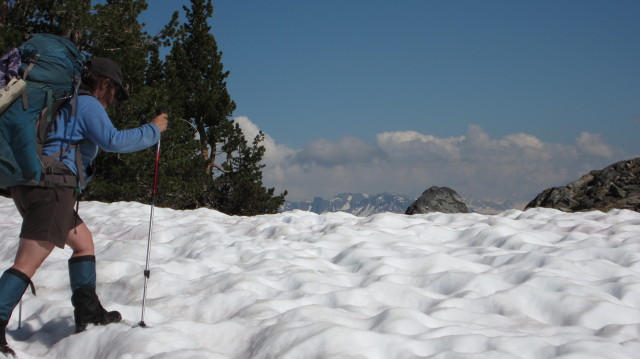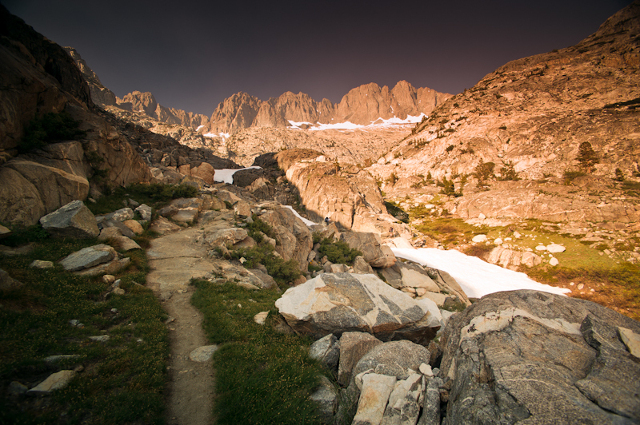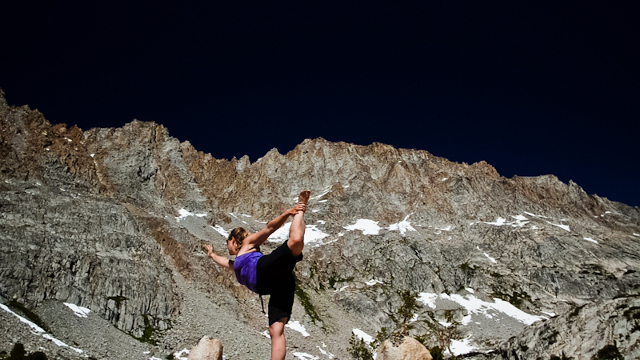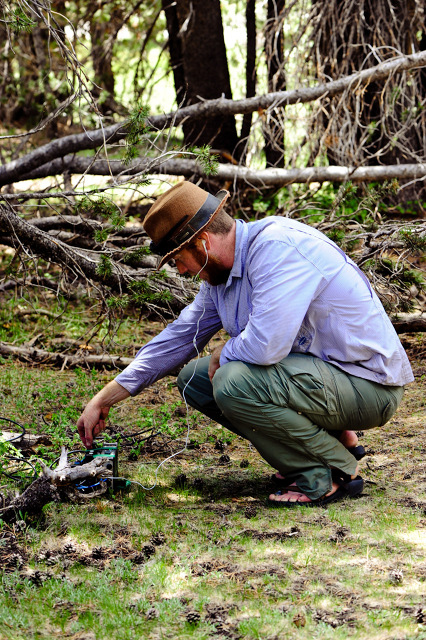SLOW WALKING
10 Mar
28 days. That’s how long it took us to hike the John Muir Trail. What surprised me the most was not that our trip was scheduled to take a month, but that other people were NOT planning on taking that long.
You only have two weeks? How can you even MOVE that fast?
This question was silently answered by the blur of feet shooting past me on the trail, footsteps dissolving into the distant mountain sounds. I just… hike… slowly.
In the beginning the slowness was from our muscles, getting used to the trail, the elevation, the cycle of the hike. Hike, hike, hike, camp, sleep, repeat. Then we had an injury in our hiking group that allowed us to experience “slow” in a new safety-focused way. Our eventual pace was just the natural speed of our Hiking. 1 mile per hour was not a-typical.
It’s hard not to want to keep pace with everyone else. Most days we would meet a hiker or a group headed in the same direction. Crossing streams goes from scary to entertaining when accompanied by a jovial group. Scrambling up the steep rocks to Mather Pass went from exhilarating to empowering in one of our only all-women hiker days.
We would occasionally run into people more than once, usually when they took a rest day or were stopped to resupply. Seeing someone for a SECOND time was like seeing an old friend! I know you! I’ve seen you more than once! Awesome!
Slowness. It actually wasn’t bad. First, there were the flowers. The moisture from the snowmelt and our lucky timing brought us a daily visual flower display. And we got excited by each and every flower we encountered. We took some pictures too (ok, several…hundred). We found silence. We learned our limits.
Yet we shared something with everyone who passed us. For every hiker on the trail, each day holds the promise of new things. New mountains, new snow, new rocks, new trail companions, new campsites, new marmots…. It’s one of the main reasons many people hike- to see new things. We hike to experience that sense of awe that captured us so easily as kids.
And we did experience that. Slowly.
FOOT NOTE: Another guest blog: this time from Mary Patterson…
a hiker we met up with several times along the JMT.
THE GOLDEN HYPE
1 Mar
There was a great deal of “hype” on the trail about ascending Mather Pass – and the the Golden Staircase – our third to last pass before ascending Mount Whitney. As with many tales of horror and dread we heard along the trail we took the comments with a grain of salt, but in the back of my mind I knew this climb was not going to be easy. I took to heart what Jen said about “hype” along the trail; the stories people tell were first hand accounts, and their experiences and perceptions were real to them! People reported falls, bleeding, exhaustion, exposure, tough water crossings and there was a Park Service Ranger warning to stay away from an area at the top of the pass where a hiker double post-holed above a 15 foot snow cave. But I don’t recall much discussion about the climb up for south-bounders. I think the reason why I heard little about ascending the Golden Staircase was because everyone we ran into was walking down it, not up.
The “staircase” began AFTER we worked our way through the Palisade burn area where we had to scramble, climb, or circumnavigate around numerous downed Jeffrey Pines littering the trail. The climb was 1500 feet almost straight up, bordering beautiful but raging Palisade Creek. The trail was completed in 1938, (according to our guide book) comprised primarily of carefully placed blocks of golden colored granite (I think, can’t find geology info on this), that switchbacked about zillion times up to Lower Palisade Lake. My plan was to take the slow and steady approach which meant I would just keep walking and stop ONLY to take photos of the amazing valley and river. We met some interesting people on this stretch, I think Mather Pass had a way of getting to people and making them a little crazy! The climb seemed to go on… and on… and on! But Durand and Jen and I just kept walking. Once the grade began to lessen (slightly!) the INCREDIBLE 14,000 foot palisade peaks came into view above us. They were absolutely ominous yet astonishingly beautiful; I don’t know that I have ever felt so small and so taken aback by a sight. It was as though the mountains were bending over the top of us to intimidate and inspire. It was relatively easy to keep walking despite the grade with the view we had.
Of course I repeatedly said to myself “I think camp is right around this corner”, and FINALLY we turned a corner and I saw Dave standing by Lower Palisade Lake. He had powered up the trail to stake-out a campsite for the group, knowing that would be the spot everyone climbing the Golden Stairs that day would want to collapse. I recall being very tired and my swollen feet hurting to the point of being numb, but as each person in our group rolled into camp there was a celebration of pure enjoyment and satisfaction for what we had all just experienced. I had been certain that Evolution Lake was the most beautiful spot on the trail, but I had to revise my mental note because the Palisade Peaks towering over Lower Palisade Lakes and the Golden Staircase had literally and figuratively taken my breath away.
TRAIL STRETCH
16 Feb
Before the JMT, I tried to hit the trails as much as possible to get prepped, but another big goal of mine was to memorize the different yoga positions I practiced with my instructor every week so I could duplicate them on the trail.
Before and after every hike, I did a few sun salutations, warrior and triangle series, and with gritted teeth – pigeon pose. Balancing on smooth angled rocks, gravel floor and wobbly legs was just an added part of the adventure.
I am certain without a single doubt that it kept me feeling good the entire time on the trail. I’ve had lower back problems in the past, but even carrying almost 50 pounds on my back up those passes, it never hurt. (My feet were another story, but you’ve heard that one already.)
Some of the guys made fun, others joined in, and by the end of the trail, there were at least four of us in downward dog after the day’s hike. And our new friend Kazu from Japan (who had never practiced before) was working her way though the poses as well.
I’m definitely no guru. I only assume I’m doing the moves right because my body feels so good afterward. All I can say is that yoga was an essential tool that I brought with me on the trail. (And it added ZERO weight to my pack.)
TRAVELING WITH SOUND
9 Feb
I’m actually back home on a gig in Seattle and just being in this environment reminded me of why I was so enthusiastic about the opportunity to join this adventure. I’ve always been a backpacker and had heard of the JMT, though only knew the absolute barest details. Doing a month long thru hike with this crew was an easy sell when they proposed the journey. Who wouldn’t want to escape into some of America’s most beautiful landscapes with a group of good friends?!
I brought along my audio gear, as I generally do, because as the cities continue to grow at an ever increasing rate, encroaching on what little protected land we have left, noise pollution has become impossible to ignore. My goal was, and always is, to capture sounds from undeveloped areas that might soon become nonexistent. Even in the most remote areas of the Sierra’s you cannot escape noise pollution from air traffic. Keeping that in mind I try to catch moments along the trail, such as stopping for a quick break, when you hear things like frogs having a conversation with each other (happened to be a particular frog that I have never heard before) or resting in a grove of aspens with a light breeze rolling through. These are the sort of moments I truly enjoy reliving when I’m sitting at home and cannot escape the incessant drone of leaf blowers.
One last note, and apologies for the rant, but I remember years ago after my first backpacking trip with PB along the Lost Coast in NorCal, and I walked into PB’s studio weeks later. He was sitting in the dark with his head down and eyes closed listening to a recording of waves crashing on a pebbled beach. I was pretty stoked at that moment to have been able to bring back some of that experience and be able to share it with others.
I’m hopeful that the Muir Project will be able to accomplish the same feat with both visuals and sound bringing the experience to a much larger audience.
THE LANDSCAPE OF SOUND
1 Feb
JMT Campfire Performance from The Muir Project on Vimeo.
The first fraction of a second in the video reveals the symphony of sounds at Lower Vidette Meadow. All of these natural sounds combine with the musical performance creating a sonic fingerprint of a specific place along the trail, it has a unique acoustic resonance that can be heard if you listen closely.
A bird sings: It is an intermittent whistling, you can hear this high pitched sound reverberate through the valley. This singing bird resounds throughout the track in key moments giving a sense of time and space illuminating the grandeur of the landscape as the sound bounces off of trees, rocks on the nearby hill, and granite cliffs in the distance.
A creek grinds: A combination of sounds fill out the lower frequencies of this track, one of which is a swift moving creek about fifty yards behind us. The cold rushing water from nearby snowmelt moves over a sand and rock bottom tugging at bushes and branches, this creek grinds out a low tone as it twists through the valley.
The shushing of trees: As the wind peels through the pines high above the camp it buzzes through the needles and branches producing a kind of white noise, this and the sound of wind through other nearby trees with larger leaves adds to the sound of rushing water and the cracking fire.
A fire hums and cracks: The fire provides a combination of chance percussion with its unpredictable pops and snaps, these sounds reside in the high to mid frequency range while a low continual breathing sound prevails from the burning.
People, Instruments and Music: This video is a culmination many different talents, from the cameras shooting both video and stills, to the recording of sound and the music, it was certainly a collaborative effort to provide a glimpse into this moment on the trail. The center of this moment is an improvisation with a ukulele and toy glockenspiel on a little composition PB and I came up with out there. The sound of the instruments reverberate throughout the environment coloring the tone and blending in with the natural elements. You can hear people humming, breathing, laughing, shuffling around and lastly clapping and talking. All of this goes into the specifics of this place and how we as people responded to it, reflecting in our expression something about what it felt like to be there.
-Bernard Chadwick (Toy Glockenspiel)





